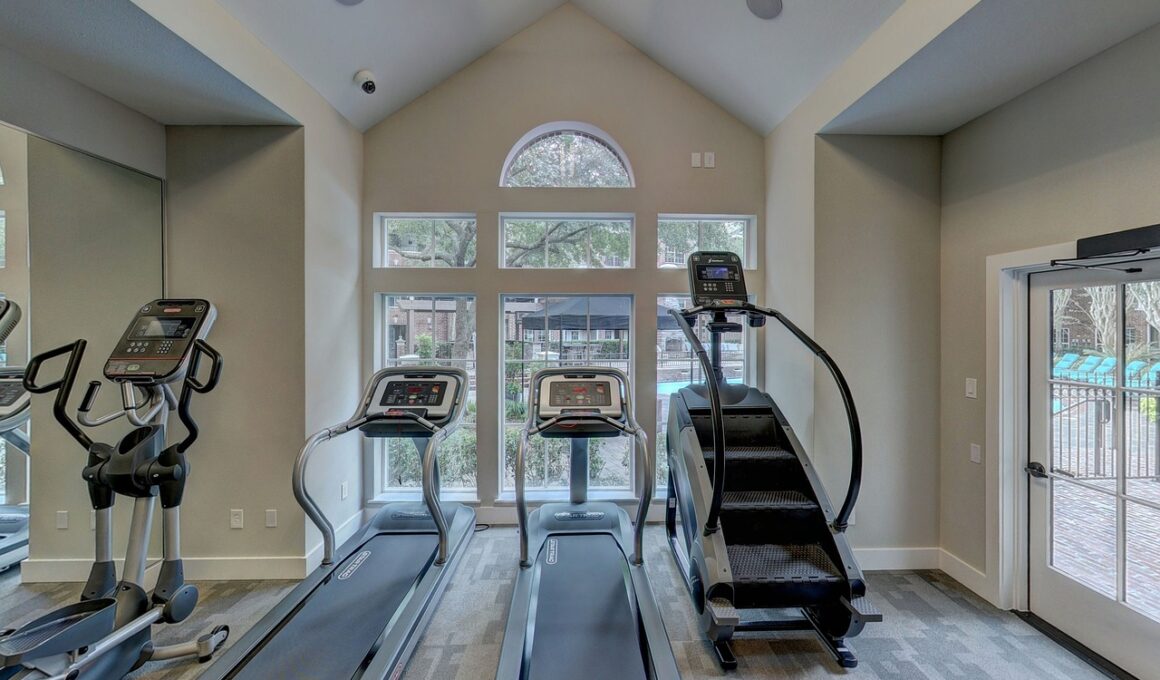Home Gym Workouts to Combat Seasonal Affective Disorder
Seasonal Affective Disorder (SAD) affects many individuals, particularly during the winter months when sunlight is scarce. This condition can lead to symptoms such as depression, lethargy, and anxiety. To combat these effects, establishing a home fitness routine can be highly beneficial. Combining physical exercise with mindfulness techniques creates an optimal environment for mental health improvement. It is crucial to create a workout space at home that is uplifting and motivating. Choose bright colors for your workout area, and add motivational posters to inspire you. Regular workouts enhance serotonin and dopamine levels, which are essential for maintaining mood stability. Incorporating a variety of exercises can keep workouts stimulating, reducing the likelihood of burnout. It might be helpful to create a weekly plan consisting of strength training, aerobic workouts, and flexibility sessions to provide a holistic approach. Additionally, pairing workouts with healthy nutrition can supercharge mental well-being. Foods rich in omega-3 fatty acids, fruits, and vegetables can elevate mood and promote overall health. Remember, investing in your fitness journey is not just about physical appearance; it profoundly impacts mental resilience and emotional stability.
Establishing a Home Workout Routine
Creating a structured home workout routine plays a significant role in combating SAD. Regularity is crucial for establishing a sense of normalcy and predictability in your life. Start by identifying your fitness goals; whether it’s enhancing strength, improving mood, or gaining flexibility, clarity will guide your regimen. Make sure to schedule your workouts at a convenient time, preferably when energy levels are highest. Each session can be varied to include various formats such as circuit training, yoga, or high-intensity interval training (HIIT), which can reinvigorate enthusiasm and help mitigate boredom. Consider using online platforms or apps designed for home workouts, which often offer guided sessions and community support. Incorporating resistance bands or free weights can add diversity to bodyweight exercises, advancing strength training without requiring extensive equipment. Personalizing your workout music can also enhance motivation. Additionally, aim for a minimum of 150 minutes of moderate aerobic activity weekly, as recommended by health professionals. This routine not only benefits your mood but also encourages adherence to a healthy lifestyle, contributing positively to self-esteem and overall mental health.
Exercise options for home workouts vary tremendously, allowing you to accommodate what works best for you. Some simple bodyweight exercises include push-ups, squats, lunges, and sit-ups, all of which require minimal space and equipment. Aim for three sets of ten to twenty repetitions per exercise, gradually increasing as strength improves. For more intensity, consider integrating plyometric movements such as jump squats or burpees. These can elevate heart rates and induce greater calorie burns, aiding in both mental and physical health benefits. Yoga and Pilates not only promote strength but also enhance flexibility and relaxation. These practices encourage mindfulness and help in stress reduction, aligning perfectly with emotional wellness strategies. To maintain motivation, consider tracking progress and setting short-term goals. Social media can also be an engagement tool; sharing your journey or participating in online fitness challenges can cultivate community support. Another option is to invest in fitness equipment like kettlebells or resistance bands, which can pose new challenges and varieties in workouts. Remember, the primary aim should be enjoyment; choose exercises that invigorate you, as this will keep you engaged and committed to your routine.
Integrating Mindfulness into Workouts
Integrating mindfulness practices during workouts can significantly enhance your overall mental well-being. The concept of mindfulness encourages individuals to be present, focus on their movements, and develop a strong connection between mind and body. While exercising, pay attention to each breath and how it correlates with your movements. Practicing deep breathing techniques can be beneficial, allowing you to access relaxation and stress relief. Incorporate meditation before or after workouts to prolong the effects of mindfulness and appreciate the exercise’s physical benefits. Another effective technique involves visualizing positive outcomes while exercising. It can keep motivation high and reinforce positive mental patterns. Consider scheduling at least once a week to practice yoga or Tai Chi, known for their meditative qualities and ability to promote inner peace. Vesting time in mindfulness and gratitude for each workout helps to cultivate a positive mindset. Keeping a workout journal that outlines feelings after sessions can also serve as an effective tool. This reflection can reinforce the mental gains made through exercise. Ultimately, intertwining mindfulness in workouts elevates both the physical and emotional health benefits that home gym workouts provide.
Consistency in home workouts can drastically improve emotional resilience during darker months. Committing to a routine actually reinforces positive habits and improves mental strength. Gradual increases in workout intensity are essential for physical progress while maintaining motivation. It’s vital to switch up routines frequently to prevent monotony, allowing you to explore different exercise types that might intrigue you. For example, try incorporating dance workouts or martial arts to keep the mood light and upbeat. Additionally, consider forming a fitness buddy system; even a virtual support partner can provide accountability and encouragement. Regular discussions about fitness progress can enhance motivation levels substantially. Hosting virtual workout sessions with friends or family can inspire a sense of community, contributing positively to well-being. As you improve, don’t hesitate to challenge yourself with higher goals. Progressing toward more ambitious targets fosters a positive cycle of achievement and growth. Balance the physical activity with adequate rest to facilitate recovery. Allowing your body to recuperate prevents burnout and keeps motivation high. This commitment to a healthy lifestyle will encourage enduring mental resilience and help to combat the symptoms of SAD effectively.
Focusing on Nutrition for Enhanced Well-being
Nutrition plays an indispensable role in mental health and should accompany any fitness regime. A well-balanced diet fuels both mind and body, promoting increased energy and stability. Emphasize foods rich in vitamins, such as B vitamins for energy and vitamin D, which is essential for mood enhancement. Incorporate healthy fats found in avocados, nuts, and seeds, as these are shown to support brain health. Additionally, consider a diet abundant in fruits and vegetables to increase antioxidants, which combat oxidative stress. Hydration is equally vital; drinking plenty of water throughout the day ensures optimal body function. Be mindful of processed foods and sugars, as they can lead to fluctuations in mood and energy levels. Preparing meals and snacks in advance can ensure healthier choices are readily available, supporting your fitness goals. Furthermore, consider consulting with a nutritionist who can provide guidance on meal plans that suit individual needs. Taking time to savor each meal through conscious eating can promote mindfulness, further aiding mental well-being. Remember, fueling your body properly enhances overall workout performance and sustains a positive mental outlook.
In conclusion, home gym workouts are a powerful tool in combating Seasonal Affective Disorder. They promote physical health while directly influencing emotional well-being and mental resilience. Establishing a routine ensures consistency and structure, which are vital during times when motivation may wane. Being mindful of nutrition further amplifies workout benefits, supporting both body and mind. Integrating various exercises can fend off monotony, keeping your fitness journey engaging. Remember to include rest days for recovery and to give yourself grace during challenging moments. Engage with others for additional support; whether friends or social media communities, these connections contribute significantly to emotional strength. The journey to better mental health via fitness may be complex, but it is entirely achievable. Reflect on your progress, remain committed, and celebrate each achievement, no matter how small. Ultimately, your home gym can transform into a sanctuary for robust mental health support. Stay empowered, and let your workout routine be a beacon through seasonal challenges, paving the way for greater emotional stability and resilience.


